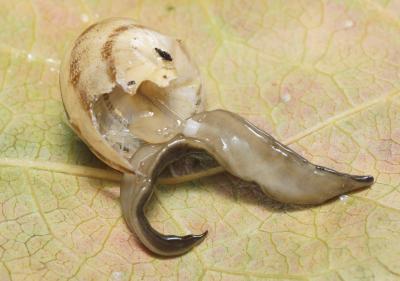One of the 100 worst invasive alien species in the world now found in Europe
One of the consequences of globalization and increased worldwide freight trade is the introduction of invasive alien species. In the list of the 100 worst invasive alien species in the world , there is only one terrestrial flatworm: Platydemus manokwari, also called New Guinea flatworm. This species has now been found in France, Caen, and was identified by an international team led by Jean-Lou Justine of Institute of Systematics, Evolution, Biodiversity, Paris, France (Muséum National d’Histoire Naturelle / CNRS / UPMC / EPHE). This is the first discovery of the species in Europe, reported in an article to be published March 4th in the open-access journal PeerJ.
The damaging effects of the New Zealand flatworm, Arthurdendyus triangulatus are already known in Europe. This species has invaded the whole north of the British Isles, including Scotland and Northern Ireland, and is responsible for significant reductions in populations of earthworms. To prevent its spread to other regions, measures have been implemented by some European countries. This species has so far never been found in France.
Now, another flatworm has been found in France and in Europe for the first time: the New Guinea flatworm, Platydemus manokwari. These flatworms were found in a greenhouse of the Jardin des Plantes de Caen (Normandy), and were identified by their characteristic appearance and molecular analysis of gene Cytochrome Oxidase Type I, often used to characterize animals. As one of the 100 most invasive alien species in the world any new discovery is clearly very concerning.
Platydemus manokwari, which was introduced – sometimes deliberately – in over fifteen territories in the Pacific, has become invasive and it consumes land snails, endangering endemic species. Indeed, although living on the ground, it is able to climb on trees to follow the snails. Very flat, it measures 50 mm long and 5 mm wide, the back is a black olive colour with a clear central stripe, and with a pale white belly. The head is elongate, with two prominent black eyes. The mouth is in the middle of the belly.
The New Guinea flatworm, although from a tropical country, inhabits the mountainous regions of New Guinea at an altitude of 3000 meters, so it can survive relatively cool temperatures down to 10 ° C. Thus, it is not impossible that the species could spread into the environment in France and much of Europe. Moreover, it was observed in the laboratory to be capable of consuming European snails. Apart from the flatworm being a threat to snails, one of the main dangers of this case is that the diet of Platydemus manokwari is very diverse and in the absence of snails it can feed on numerous soil-dwelling species, including earthworms.
Platydemus manokwari represents a new and significant threat to biodiversity in France and Europe, which hosts hundreds of species of snails, some of which are endangered and protected. It is therefore important to consider the implementation of eradication and control of this flatworm.


